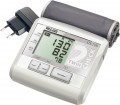Add to comparison |  |  |
|---|---|---|
| Nissei DS-700 | Nissei DS-1031 | |
from $73.64 up to $75.16 | from $62.00 up to $77.80 | |
| TOP sellers | ||
| Type | auto | auto |
| Place of measurement | shoulder | shoulder |
| Power source | batteries / mains | batteries / mains |
| Battery indicator | ||
| Device dimensions | 140x135x51 mm | 115x115x67 mm |
Specs | ||
| Pressure measuring range | 40 – 250 mmHg | 40 – 250 mmHg |
| Pulse measurement range | 40 – 160 bpm | 40 – 160 bpm |
| Cuff dimensions | 22 – 32 cm | 22 – 42 cm |
| Recording readings | 60 pcs | 120 pcs |
Features | ||
| Functions | pulse measurement determination of arrhythmia medium pressure calculation measurement error signal auto switch-off | pulse measurement determination of arrhythmia medium pressure calculation measurement error signal auto switch-off |
| Added to E-Catalog | march 2013 | march 2013 |